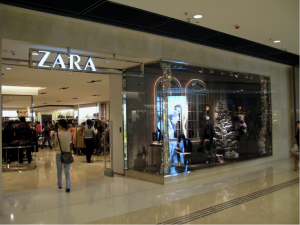It’s not very rare to see people in Vancouver carry a luxury bag or wear a luxury outfit. However lately I have found out luxury brand has become more and more popular and the sense of scarcity and luxury is fading away. Luxury brand are supposed to emphasize social status of rich people. Understating the brand position of rich class will lead luxury brands to dead ends for sure.
I agree with the point stated in Jim’s blog: the luxury brands cannot believe that staying where they are currently without repositioning and renovating their brands can lead to their success or even survival. Due to the fact that the next generation is highly-educated and will have different values towards luxury, Luxury brands need to catch up with consumers taste changes or even value change. How can luxury brands persuade the next generation that luxury brand is not just about showing off is going to be extremely important. My opinion is that luxury brand should create a image of art piece rather than a practice of money worship. Brands that can be able to link their product towards other perception rather than pure expensive image will have add to their point of difference. An example of incorporating art elements into production is Hermes scarves production. Hermes designs its scarf like a piece of art. Every graphic pattern on the scarf is like a painting. In deed, many consumers purchase Hermes scarves for its graphic design combined with the luxury value it holds.
Monthly Archives: November 2012
This Is Why I love Zara
 Having more than half of my closet filled with Zara’s clothes, the class of the supply chain management with Zara as an example immediately caught my attention. I remember back in high school, most of my classmates wore the similar styles of clothes. It was awkward to find everyone else in the class in the same dress. After I started shopping at Zara’s, I found it rare to see anyone else in my class that wears the same outfit. Now I understand that it’s under Zara’s unique strategy to maintain high variability of its clothes. I didn’t know how could having so many styles of design help Zara earn more profits. Now I come to see that Zara tries to create a scarcity by limiting the amounts of each design. And this is why I go to Zara almost every month to check out if there are new items that are available. With no doubt, I always can find some new items that attractive me. And as a result, I keep contributing money to Zara each time I go to their store.
Having more than half of my closet filled with Zara’s clothes, the class of the supply chain management with Zara as an example immediately caught my attention. I remember back in high school, most of my classmates wore the similar styles of clothes. It was awkward to find everyone else in the class in the same dress. After I started shopping at Zara’s, I found it rare to see anyone else in my class that wears the same outfit. Now I understand that it’s under Zara’s unique strategy to maintain high variability of its clothes. I didn’t know how could having so many styles of design help Zara earn more profits. Now I come to see that Zara tries to create a scarcity by limiting the amounts of each design. And this is why I go to Zara almost every month to check out if there are new items that are available. With no doubt, I always can find some new items that attractive me. And as a result, I keep contributing money to Zara each time I go to their store.
However this strategy would not be successful if Zara doesn’t keep the high turnover rate of its products. In order to obtain the first hand information from markets, it is so smart of Zara to predict trend by actively listening to what customers like and dislike. Recalling from my experience, if a line is selling well, Zara will re-launch it in a different color that has been selling well in other lines. Zara always takes good care of fresh customer opinions and preferences. Unlike other fashion chains that predict the trends all ahead and thus have a higher risk of failing, Zara gets all the fresh feedbacks from its stores and immediately work toward these feedbacks. This customer-to-production strategy will be an inevitable trend for fashion producers.

Links for further reading:
http://www.bbc.co.uk/news/business-19749074
http://thesoundingsgroup.com/zara-a-global-success-story-november-1-2011/
What Apple Tries To Gain From iPad Mini?
After Apple launched its reduced size tablet- the iPad Mini, I visited the Apple store in downtown Vancouver to find out what exactly this product looks like. During the half hour stay in the store, I found out that many people just come to the store to check out the iPad Mini and there were more women than men that stopped to touch this brand new product.

Although some people complain that Apple has become less and less innovative so that it just reduces the size of the original iPad and comes up with the iPad Mini. While in my opinion, the iPad Mini will become another huge success of Apple.
From the very first test of iPad Mini, I immediately fell in love with this product. I love holding it. The iPad mini weighs almost nothing, which makes it a better option for reading long periods of time. Mentioning reading, it’s necessary to point out that Apple’s key strategy in launching iPad Mini is to go on to the defensive battle competing with Google’s Nexus 7 and Amazon’s Kindle Fire. Obviously Apple can’t neglect the fact that other tablet s are emerging and taking away its potential market. In my opinion, it is necessary for Apple to have the iPad mini to prevent its consumers from turning to other lighter tablets of its competitors. In fact, Apple’s initial marketing campaign for the new iPad mini is focusing on attracting women since women are the dominant owners of high end e-reader. By targeting women, Apple will not only be able to keep its potential e-reader consumers but also increase the popularity of the iPad.
Another reason that I think iPAD mini will be successful is as always crediting to Apple’s brilliant marketing strategy. On its official Apple website, it positions the iPad mini as “the whole package, in a smaller package”. It also mentions “the full iPad experience ” for iPad mini. Again Apple tries to focus on its point of difference to convince consumers that the iPad mini is an advancement of the iPad.
Links for further reading:
http://qz.com/19314/apple-has-a-clear-target-with-its-ipad-mini-advertising-women/
http://www.apple.com/ipad-mini/overview/
Re External Blog Post- “BlackBerry By Choice Is Bad Marketing By Choice”
In the blog “BlackBerry by choice is bad marketing by choice” on Canadian Business, it talks about a funny borderline immature stance in BlackBerry’s marketing. When many of BlackBerry users are ashamed of their outdated devices, BlackBerry responses to the complaints by pointing out that the only reason people still use BlackBerrys is because their employer forces them to through its new slogan “BlackBerry by choice”. I agree with most of the points in this blog. A company should never point out its own products’ shortcomings in its advertising, When the competitors of BlackBerry are all being very innovative and at the same time very influential to bring up the power of the products, it is an irony for BlackBerry to promote its products as a cellphone by choice. In reality, it totally disappoints those of who are forced to use BlackBerry. The BlackBerry case raises a series of questions about how a once powerful company can use marketing to help it survive? How can advertisements help them remind consumers of its strengths? How should the company create a new image to catch up with the main trend? “BlackBerry by choice” obviously has none of the effect on catching consumer’s attentions or creating abpositive image for the company.
Links for further reading:
http://www.canadianbusiness.com/blog/tech/104855–blackberry-by-choice-is-bad-marketing-by-choice
A Close look at KFC’s Success In China
Each time I go back to China, there is a phenomenum that always catches my attention. In China, almost every KFC restaurant is fully occupied during peak hours. And it’s hard to believe that there is always a long lineup for ordering food. Coming back to here in North American, KFC is never up to the top since the giant competitor Macdonald’s is the mainstream choice. After doing some research, I found that there are more than 3700 KFC locations in over 700 cities in China and people are flocking to these locations. This once rather lack-luster American fast food brand, outperformed all competitors, to become the biggest restaurant chain in China.
 What exactly has made KFC so successful in China that almost every Chinese is so familiar with this western brand? It always seemed so mysterious for me to understand it. Now after learning the brand-positioning and marketing strategy lesson from COMM101, I see this success is not a mystery, it is a result of smart business strategies.
What exactly has made KFC so successful in China that almost every Chinese is so familiar with this western brand? It always seemed so mysterious for me to understand it. Now after learning the brand-positioning and marketing strategy lesson from COMM101, I see this success is not a mystery, it is a result of smart business strategies.
The first factor underpinning KFC’s success is no doubt product localization. In China, KFC recruit a local senior management team to explore the Chinese culture and Chinese consumer preference. It focuses specially on catering to Chinese taste. The menu it has in China is much more diversified, which includes even traditionally Chinese congee (rice porridge) and youtiao (a kind of Chinese doughnut). Both are the quintessential Chinese breakfast. Besides, KFC in China frequently designs new menus that develop numerous more localized choices. In contrast, Macdonald’s does not realize how important it is to localize the products. It keeps its muffin and coffee breakfast menu that Chinese seldom choose for breakfast. This explains a lot why Macdonald’s is falling behind in Chinese market.
The second main reason is that KFC invests a lot in advertising and brand positioning in China. Its TV commercials play on Chinese TVs almost through out the year. Every new product is advertised through TV commercial and due to that fact that many Chinese watch TV, the marketing strategy is extremely successful. Although KFC is a fast food restaurant and its products are always considered as junk food, it tries to promote itself as a new fast food in China. It tries to convince Chinese that its products are nutrition-balanced and healthy. KFC regularly holds events such as basketball game for teenager to participate. This strategy makes consumers connect KFC with healthy life style.
No wonder that “in China, people have really caught on to KFC”. KFC has developed its products perfectly suitable for Chinese stomachs. Being the first western fast food company that entered China, it obviously has left an image of the leading brand in the minds of Chinese consumers.
Links for further reading:
http://www.echinacities.com/expat-corner/junk-food-in-china-why-so-popular.html
http://articles.businessinsider.com/2012-02-08/strategy/31036609_1_china-pizza-hut-development-team
RE: Jenny Ling’s Post “Are Free Samples of Brand-Name Baby Formula in Hospitals Unethical?”
While scanning through all the different blog posts, the question in one of Jenny Ling’s blog titles immediately drew my attention. Although giving free samples of baby formula could be seen as an endorsement, it does not raise a business ethical issue here.
First of all, there are no food safety problems with the baby formula samples that are given out. Secondly, giving free sample away has historically been an acceptable way of advertisement. If it is fine for a chips company to give out free sample in supermarkets, what is wrong with baby formula companies to give out free samples of the same product? The argument that giving free sample of baby formula will affect women’s decisions on whether or not to breast feed does seem to have a strong reason. This argument is just like the argument that giving out free chips in supermarkets will promote junk food.
It is always good for consumers to have more information, not less. In this case, women are open to more choice of reliable baby formula enable them to choose a better product for their babies if they decide to breast feed. If mothers don’t want to choose feed their babies with baby formula, the advertisement will have no effect on them. The situation is just like advertising of cigarettes will have no effect on non-smokers. Indeed this advertising strategy focuses on the specific group of consumers- mothers that who don’t want to breast feed. It facilitates the promotion process and brings consumers benefits at the same time.
